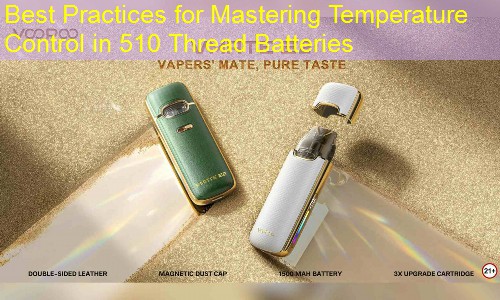Understanding the Functionality of 510 Thread Battery Temperature Control

Temperature control (TC) has become an essential feature in the vaping community, especially for those who prioritize safety and flavor in their experience. The 510 thread battery stands at the center of this evolution, significantly enhancing the vaping experience by offering the capability to manage coil temperatures effectively. With a refined understanding of TC, vapers can enjoy a customized and safer vaping experience that minimizes the risk of dry hits or overheating.
1. The Basics of 510 Thread Batteries
510 thread batteries are designed to be compatible with a wide variety of atomizers and tanks, making them one of the most versatile components in the vaping ecosystem. The term “510” references the threading size used to connect the battery to the tank, which features a standard 10 mm diameter and 5 threads. This universal design enables users to mix and match gear, providing a tailored vaping experience that suits individual preferences.
2. What is Temperature Control?
Temperature control technology allows users to set a specific temperature for their coils, instead of simply adjusting the wattage. This is fundamental for preventing coils from exceeding the desired temperature, which can lead to undesirable effects such as burnt wicks and excessive throat irritation. Most modern 510 thread batteries equipped with TC use nickel (Ni200), titanium (Ti), or stainless steel (SS) coils, which can accurately relay temperature readings back to the device.
3. Benefits of Using Temperature Control with 510 Thread Batteries
The benefits of utilizing temperature control technology are significant:
– Consistent Vapor Production: By maintaining a stable temperature, vapers can enjoy a consistent vapor output, enhancing the overall satisfaction of the experience.
– Flavor Preservation: Elevated temperatures can degrade the flavor compounds in e-liquids. TC allows users to enjoy richer flavors by preventing the coil from overheating, thereby preserving the integrity of the e-liquid.
– Extended Coil Life: Overheating can lead to rapid coil degradation. By utilizing TC, users can extend the life of their coils significantly, thereby reducing replacement costs.
– Preventing Dry Hits: A common issue for vapers is a “dry hit,” which occurs when the coil is not adequately saturated with e-liquid. TC can help to mitigate this problem by maintaining optimal temperatures that ensure consistent wicking.
4. Key Features of 510 Thread Battery Temperature Control
Numerous features enhance the temperature control experience on 510 thread batteries:
– User-Friendly Interfaces: Many batteries come equipped with intuitive interfaces, making it easy for users to adjust the temperature settings as per their preference.
– Precision Adjustments: The ability to incrementally move the temperature setting by a few degrees allows for optimized control over the vaping experience.
– Safety Features: Modern batteries often include built-in protections such as short circuit protection, overcharge protection, and low resistance alerts, thereby ensuring a safe experience while using temperature control.
– Compatible Coils: The variety of compatible coil materials such as Ni200, titanium, and stainless steel provides flexibility in choosing the best setup for individual preferences.
5. How to Set Up Temperature Control on a 510 Thread Battery
Setting up temperature control is straightforward:
1. Install the Coil: Ensure to use a compatible TC coil, properly attach it to the 510 battery.
2. Select Temperature Mode: Most devices have a specific mode for TC; simply navigate to this setting.
3. Adjust Temperature: Use the controls to set your desired temperature, commonly ranging from 200°F to 600°F (100°C to 315°C).
4. Vape: Once set, begin vaping at your selected temperature.
6. Common Challenges and Solutions
While the integration of temperature control is intended to enhance the vaping experience, some challenges may arise:
– Coil Detection Issues: Sometimes, the device may not accurately detect the coil material. Ensure that the correct coil type is selected in the device settings.
– Temperature Fluctuations: This can occur if the coil is not properly saturated with e-liquid. Always ensure that the wick is adequately primed before use.
– Learning Curve: New users might take time to adjust to TC. A gradual approach to finding the ideal settings can ease this transition.
Conclusion
Incorporating temperature control in 510 thread batteries transforms the vaping experience by delivering consistent vapor production, extensive coil longevity, and enhanced flavor preservation. Understanding the intricate details surrounding 510 batteries and temperature control empowers users to maximize their vaping sessions while prioritizing safety. As technology continues to evolve, vapers can expect even more innovative features that further enrich their experience.













